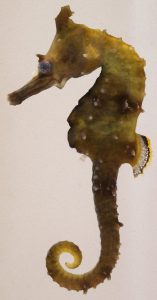Abstract / Introduction / Summary:

The seahorse genus Hippocampus Rafinesque, 1810, belonging to the family Syngnathidae which also includes pipefishes and seadragons (Mobley, 2011), comprises 42 valid species (Lourie et al., 2016; Zhang et al., 2016). In Japanese waters, the genus is currently represented by eight species viz., Hippocampus bargibanti Whitley, 1970; H. coronatus Temminck and Schlegel, 1850 (Japanese name: Tatsuno-otoshigo), H. histrix Kaup, 1856 (Ibara-tatsu), H. kelloggi Jordan and Snyder, 1901 (O-umiuma), H. kuda Bleeker, 1852 (Kuro-umiuma), H. mohnikei Bleeker, 1853 (Sango-tatsu), H. sindonis Jordan and Snyder, 1901 (Hana-tatsu) and H. trimaculatus Leach, 1814 (Takakura-tatsu) (Lourie et al., 2004; Motomura et al., 2010; Senou, 2013; Lourie et al., 2016; Motomura and Harazaki, 2017). Apart from H. mohnikei, the above species have all been recorded from Kagoshima Prefecture (Kagoshima City Aquarium Foundation, 2008; Motomura et al., 2010; Senou, 2013; Matsunuma, 2014; Iwatsubo et al., 2016; Motomura and Harazaki, 2017), Japanese records of the former having been limited to waters from Hokkaido to Ehime and off Kumamoto prefectures (Yagi et al., 2011; Senou, 2013). A single specimen, collected from off Chiringa-shima island, Ibusuki, Kagoshima Bay and described herein, represents the first confirmed record of the species from Kagoshima Prefecture. In addition, the fish diversity surveys conducted off Kagoshima Prefecture since 2006 by the Kagoshima University Museum (KAUM) has resulted in more than 100,000 specimens collected and deposited in the museum. These include examples of six of the eight species of Hippocampus recorded in Japan.
